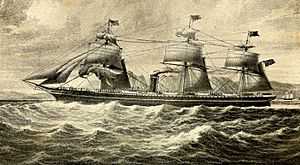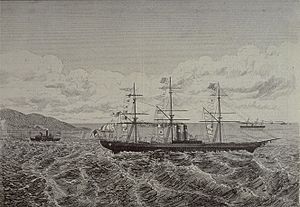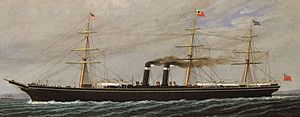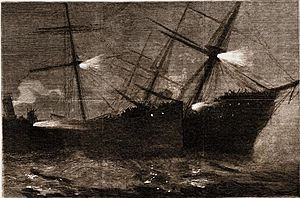SS City of Brussels facts for kids

City of Brussels
|
|
Quick facts for kids History |
|
|---|---|
| Name | City of Brussels |
| Owner | |
| Route | Atlantic crossing |
| Builder | Tod and Macgregor, Partick, Glasgow |
| Launched | 11 August 1869 |
| Fate | Sunk in collision 7 January 1883 |
| General characteristics | |
| Type | Passenger liner |
| Tonnage | 3,100 tons |
| Length | 390 ft (120 m) |
| Beam | 40 ft (12 m) |
| Sail plan | 3 masts |
The City of Brussels was a British passenger liner. This amazing ship set a record in 1869. It made the fastest trip across the Atlantic Ocean going east. It was also the first record-breaking ship to be powered by a screw propeller. Built by Tod and Macgregor, the ship worked for the Inman Line company. Sadly, in 1883, it sank after crashing into another ship. Ten people lost their lives in the accident.
Contents
Building the City of Brussels
In 1866, the Inman Line ordered a ship called City of Paris. This ship was as good as the best ships from the Cunard Line. The next year, the British Post Office took over mail contracts. Inman Line won contracts to deliver mail to New York City and Halifax, Nova Scotia. These contracts helped Inman Line build more fast ships.
The City of Brussels was designed to be a partner for the City of Paris. It was built by Tod & Macgregor in Partick, Glasgow. The ship was made of iron. It could carry 200 first-class passengers and 600 passengers in steerage. Steerage was a part of the ship for passengers who paid less.
Ship's Size and Features
The City of Brussels was 390 feet (about 119 meters) long. It was 40 feet (about 12 meters) wide. This made it one of the first "long boats." It also had a new feature: steam steering gear. This was the first time such a system was put on a passenger ship. The ship was powered by a special steam trunk engine. This engine was also made by Tod & Macgregor.
City of Brussels at Sea
In its first year, the City of Brussels broke a record. It traveled from New York to Queenstown in 7 days, 20 hours, and 33 minutes. It sailed at a speed of 14.74 knots. However, in 1870, the ship showed a problem with single-screw ships. It lost its propeller and had to sail back to Queenstown using only its sails.
Three years after it started service, the City of Brussels went back to the shipyard. Workers added an extra deck and made other changes. These updates made it similar to the new ships built by the White Star Line. After these changes, the ship's size was listed as 3,750 tons.
In 1876, the ship got a new, more efficient compound engine. This new engine used less coal. It went from using 110 tons of coal per day to just 65 tons. This also meant the ship could carry more cargo. At this time, it also got a second funnel. But even with these changes, the ship still had problems with its propeller shaft. On April 23, 1877, the shaft broke again. The ship had to return to port using its sails.
The Final Voyage
On January 7, 1883, the City of Brussels was returning from New York. It had dropped off some passengers and mail at Queenstown. As it entered the Mersey River, it ran into heavy fog. The captain ordered the ship to stop and wait for the fog to clear.
Another ship, the Kirby Hall, was on its first trip. It was a new cargo ship sailing from the River Clyde to Bombay via Liverpool. The Kirby Hall hit the City of Brussels on its right side, near the front. The crash almost cut the City of Brussels in half.
After the Collision
When the ships separated, water quickly filled the holds and engine room of the City of Brussels. The ship sank in just 20 minutes. Two passengers and eight crew members lost their lives. Sixty-four passengers and ninety-three crew members were rescued by the Kirby Hall.
Later, an investigation was held. It was decided that the Kirby Hall caused the crash. Even though it was slowing down, it failed to stop its engines when it first heard the City of Brussels' whistle.
Finding the Wreck
In 1984, the wreck of the City of Brussels was found. A group called the Wirral Sub-Aqua Club found it. The ship lies in 24 meters (about 79 feet) of water, near the Mersey Bar. On the day it was found, the ship's bell was brought up. The bell was later sold, but its current location is unknown.
In 1998, one of the ship's two cannons was raised. This was done by the Mersey Divers club. After six years of being preserved, the cannon is now on display at the club's boathouse.




